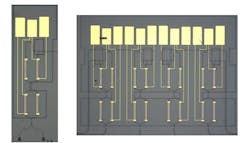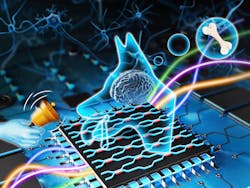AI hardware challenges conventional system designs
University of Oxford (U.K.) researchers are challenging the idea that the lone building blocks of artificial intelligence (AI) systems are artificial neurons and synapses.
Inspired by Pavlovian associative learning, the team has developed an on-chip optical processor, an AI hardware system that is nearly 1000X faster at detecting dataset similarities than existing electronic processor-fueled machine learning algorithms (see Figs. 1 and 2, and video below). The study was published in Optica.Dr. James Y. S. Tan, a researcher with the Bhaskaran Lab in Oxford’s Department of Materials, says at its core, the new AI hardware is grounded in physiologist Ivan Pavlov’s discovery of classical conditioning. In his Nobel Prize-winning work, Tan found that offering dogs a stimulus at feeding time—for example, sounding a bell—prompted association between the two experiences. And, eventually, the sound alone motivated their reactions to food.
“The repeated associations of two unrelated events paired together could produce a learned response—a conditional reflex,” Tan says. “We now have a way to approach certain AI tasks more efficiently using a unique network architecture that incorporates associative learning as a building block.”
Conventional AI, in the form of neural networks, can learn associations. But it requires numerous data examples during training. This means “very large computational effort and numbers of computation cycles,” Tan says, noting that with the new hardware, his team can delineate the reasons why the system arrives at a given solution. “Our approach of explicitly detecting similar features in datasets and associating them without having to randomize network weights and perform backpropagation, as is required in conventional AI, results in faster computations.”
16X faster computation speed
Using wavelength-division multiplexing, the new optical processor sends multiple optical signals on different wavelengths on a single channel to increase computational speed. The increased speed is attributed to the researchers’ use of optical signals as well as the AI architecture itself. For example, by using 16 distinct optical wavelengths, the computation speed can be 16X faster. In a task involving recognition of 128 patterns, the new associative learning system can solve within one to three orders of magnitude faster than conventional AI approaches.
The system enables associations when multiple input signals (from multiple separate datasets) are simultaneously sent to the device. The device has a memory material capable of storing information using its atomic arrangements. When sending multiple input signals, they sufficiently heat up the memory material to change the atomic arrangement of the material. As a result, the optical losses change—and the change is measured to determine if the device has learned or not.
“Our use of light as a data signal on the hardware enables multiple signals of different wavelengths to be simultaneously sent in parallel on a single channel,” Tan says. This is an advantage over electron-powered AI hardware that the researchers have incorporated into their new associative learning hardware.
Their work lays a path for development of optical computers that capture data associations quickly. According to Tan, such computers would be ideal for AI-related problems—including logical inferencing, expert system tasks, constraint satisfaction, and natural language processing—that require swift detection and reasoning for how the computation system arrives at a certain solution.
The new system is suitable, too, for AI problems that don’t require extraction of complex (unapparent and abstract) features within datasets.
About the Author
Justine Murphy
Multimedia Director, Digital Infrastructure
Justine Murphy is the multimedia director for Endeavor Business Media's Digital Infrastructure Group. She is a multiple award-winning writer and editor with more 20 years of experience in newspaper publishing as well as public relations, marketing, and communications. For nearly 10 years, she has covered all facets of the optics and photonics industry as an editor, writer, web news anchor, and podcast host for an internationally reaching magazine publishing company. Her work has earned accolades from the New England Press Association as well as the SIIA/Jesse H. Neal Awards. She received a B.A. from the Massachusetts College of Liberal Arts.


